Overview
The American Diabetes Association 504 Plan plays a vital role in ensuring that students with diabetes receive the accommodations they need for their health and educational success. It's essential to recognize that this plan is not just about medical adjustments; it’s about fostering an inclusive environment that can significantly enhance learning outcomes for these students.
Collaboration is key. Parents, educators, and school staff must come together to implement this plan effectively. When everyone works as a team, it not only supports the student's individual needs but also creates a nurturing atmosphere where they can thrive. It’s understandable to feel overwhelmed by the responsibilities that come with managing diabetes in a school setting, but remember, you’re not alone in this journey.
We encourage you to reach out for support and resources. Engaging in open conversations about your child's needs can make a world of difference. Together, we can ensure that every student feels valued and empowered to succeed.
Introduction
In the realm of education, it is crucial to ensure that students with diabetes receive the support they need for both their academic and social success. The 504 Plan serves as a vital tool, offering a structured framework that outlines essential accommodations tailored to meet the unique needs of these students. With approximately 1 in 400 children in the U.S. diagnosed with Type 1 diabetes, the need for effective support systems in schools is more important than ever.
This article explores the intricacies of the 504 Plan, highlighting its significance, the legal protections it provides, and the collaborative efforts needed from parents and educators to foster an inclusive learning environment. By understanding the components and processes involved, you can advocate for the necessary modifications that empower students to thrive despite their health challenges.
You're not alone in this journey; together, we can create a supportive atmosphere for every student.
Understanding the 504 Plan: A Foundation for Support
The 504 strategy serves as a crucial framework that outlines the specific adjustments needed for individuals with disabilities, including those managing blood sugar issues. As highlighted by the American Diabetes Association 504 plan, it ensures equitable access to education. This formal document is vital for enabling individuals to manage their health needs effectively while fully participating in school activities. With the rising prevalence of Type 1 diabetes among school-aged children—recent statistics indicate that approximately 1 in 400 children in the U.S. are diagnosed—the importance of the 504 strategy is clear.
Moreover, the financial implications of managing this condition are significant. The additional healthcare costs associated with it have increased from $10,179 in 2012 to $12,022 in 2022, underscoring the need for effective support systems within educational settings. Recent updates to the 504 accommodations reflect a growing recognition of the unique medical needs of affected students. These accommodations may include provisions for:
- Regular blood sugar monitoring
- Access to snacks and water
- The ability to take breaks as necessary
Physical activity plays a vital role in managing blood sugar levels, and students with Type 1 diabetes may require additional support during exercise. Such measures are essential for fostering a safe and supportive educational environment, enabling learners to thrive both academically and socially.
Parents and educators have a pivotal role in advocating for the implementation of the American Diabetes Association 504 Plan. Understanding its components is essential for effectively meeting the needs of individuals with health conditions related to blood sugar. Successful execution of this plan has been shown to positively influence educational outcomes, creating an environment where students can focus on learning without the added burden of managing their condition alone.
Furthermore, disparities in disease prevalence among different racial and ethnic groups highlight the necessity for culturally sensitive management strategies within the framework of the 504 initiative.
Experts emphasize the significance of the 504 initiative in supporting individuals with disabilities. It not only facilitates essential medical accommodations but also fosters inclusivity within the school environment. By ensuring that individuals with blood sugar issues receive the assistance they require, the 504 framework helps level the playing field, allowing them to engage fully in all aspects of school life.
Importantly, individuals with diabetes in postsecondary education are also protected under federal regulations and can seek reasonable accommodations from their educational institutions, extending the relevance of the 504 framework beyond K-12 education.
In conclusion, the American Diabetes Association 504 plan is an invaluable resource for parents and educators, ensuring that individuals with diabetes receive the necessary support to succeed in their educational journey. By advocating for these essential changes, they can help create a more inclusive and supportive atmosphere that addresses the unique challenges faced by individuals with diabetes.

Legal Protections: The 504 Plan and Disability Rights
The 504 Plan is rooted in Section 504 of the Rehabilitation Act of 1973, a vital law that protects individuals with disabilities from discrimination in programs receiving federal funding. This important framework recognizes that individuals with blood sugar issues may be considered disabled if their condition significantly limits one or more major life activities, such as learning. Therefore, schools are obligated to provide necessary adjustments to support these individuals effectively.
These adjustments can take many forms, including:
- Allowing access to medical care during school hours
- Permitting individuals to carry their supplies
- Modifying testing conditions as needed
For instance, some schools have implemented adjusted class schedules and specialized testing arrangements designed specifically to support those managing their health. Such accommodations are crucial, as approximately 1 percent of individuals with disabilities are classified as other health impaired, which includes those with blood sugar issues, highlighting the need for personalized support.
Recent legal developments emphasize the importance of these protections. A significant case, Texas v. Becerra, involves a lawsuit filed by 17 states against the U.S. Department of Health and Human Services, challenging the classification of gender dysphoria under Section 504. If this lawsuit succeeds, it could undermine Section 504, making it more difficult for students to qualify for necessary accommodations and stripping vital protections from millions who rely on these supports for their education.
Understanding these legal rights through the lens of the American Diabetes Association 504 Plan empowers parents and educators to advocate effectively for individuals with health conditions, ensuring they receive the support needed to thrive in their educational settings. By fostering a collaborative approach, schools can enhance health outcomes through shared knowledge and support, ultimately benefiting everyone involved. This community-driven initiative is essential in promoting the rights and needs of individuals with health conditions, ensuring they have the resources necessary to flourish.
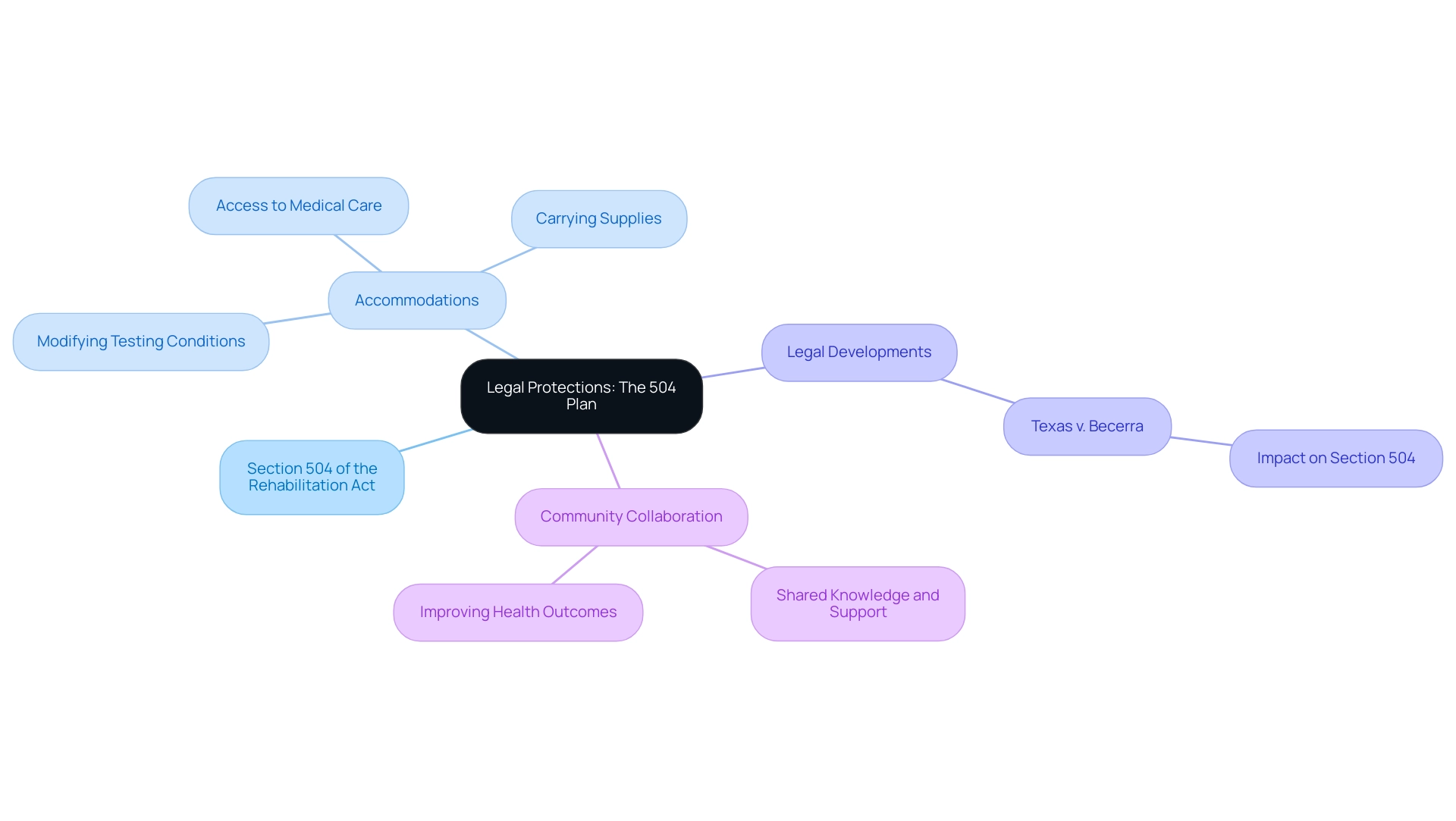
Tailoring the 504 Plan for Students with Diabetes
Creating an American Diabetes Association 504 plan for someone living with diabetes requires a thoughtful approach that truly considers their unique medical needs and the potential effects on their educational experience. Essential accommodations often include:
- Allowing individuals to check their blood glucose levels and administer insulin as needed
- Ensuring they have access to snacks and water throughout the day
- Permitting extra time for bathroom breaks
It's also crucial that the plan clearly outlines procedures for managing diabetes-related emergencies, with specific training for school staff to ensure they can respond effectively.
The Diabetes Medical Management Plan (DMMP) includes specific medical orders for checking blood glucose and administering insulin, which are vital components of the accommodations outlined in the American Diabetes Association 504 Plan. Collaboration among healthcare providers, parents, and school personnel is essential in developing this comprehensive plan. This teamwork not only fosters a supportive environment but also empowers individuals to manage their condition confidently while pursuing their education. As Anastasia Albanese-O’Neill, a nurse educator specializing in blood sugar management and co-chair of the American Diabetes Association 504 plan's Safe at School Working Group, emphasizes, building a strong connection with the 504 team can significantly enhance the effectiveness of the American Diabetes Association 504 plan accommodations, allowing for adjustments based on the learner's progress and needs.
In 2025, the importance of accommodating individuals with blood sugar issues in educational settings has become even more critical. Statistics show that effective management strategies can lead to better health outcomes. The American Diabetes Association provides various resources for managing this condition in schools, including guidelines for medication administration and the rights of individuals living with this illness, promoting a safer and more supportive school environment. By customizing the 504 arrangement to include specific adjustments—such as flexible scheduling for medical needs and designated areas for health management—schools can create a safer and more inclusive atmosphere for individuals living with diabetes.
You're not alone in this journey, and we are here to support you every step of the way. Remember, effective communication and collaboration can make a significant difference in managing diabetes within the school setting.
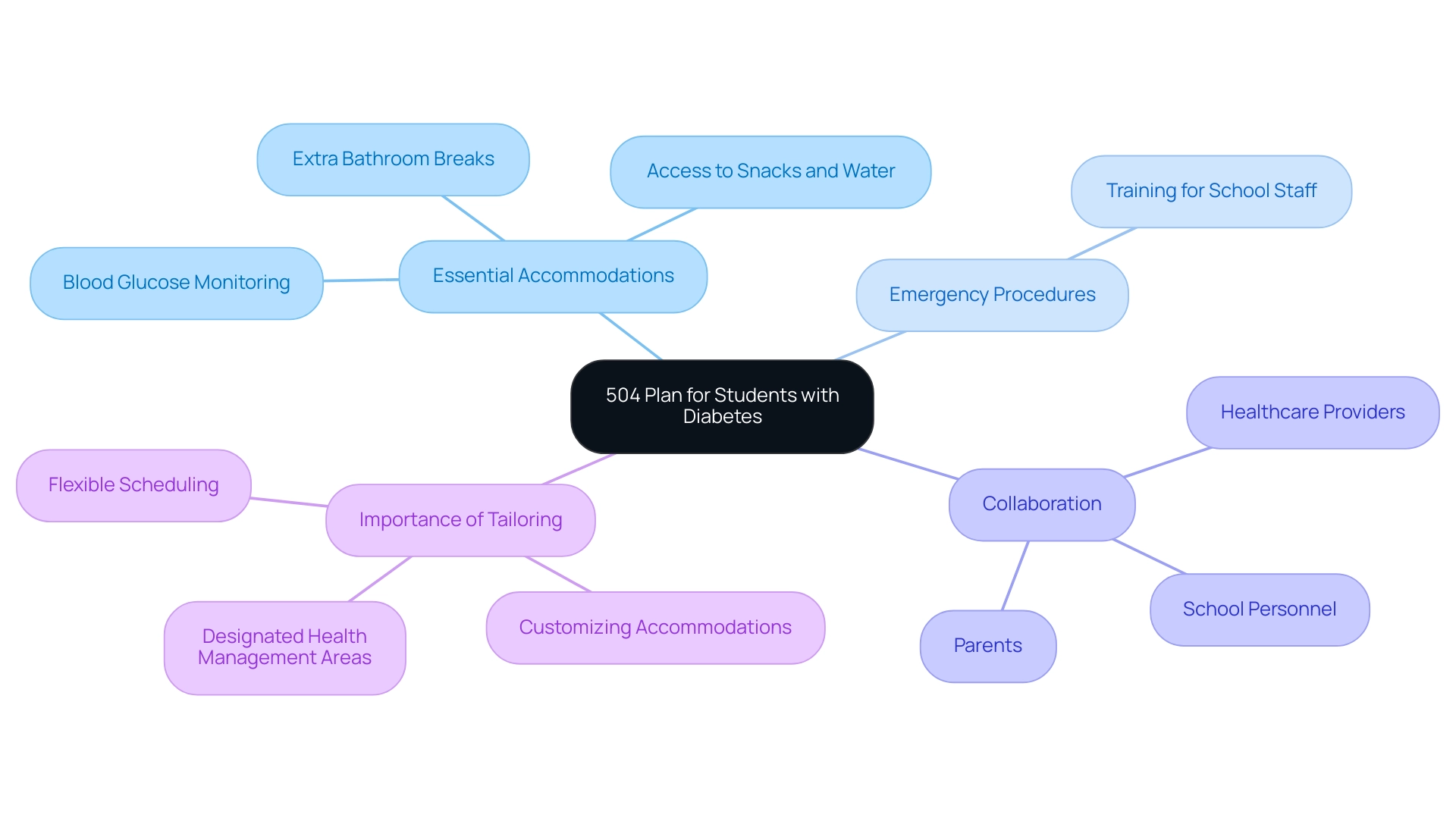
Collaboration Between Parents and Educators: Implementing the 504 Plan
Implementing the American Diabetes Association 504 Plan requires a proactive partnership among parents, educators, and school staff. Open communication is vital; parents should engage in discussions with teachers and school administrators to clearly express their child's specific needs. It’s essential that everyone involved is well-informed about the accommodations outlined in the American Diabetes Association 504 Plan.
Scheduling regular meetings creates a space for ongoing dialogue about the individual's progress and any necessary adjustments to the plan, ensuring that it remains effective and relevant.
T2DSolutions serves as a valuable resource hub for families navigating 504 Plans and managing blood sugar. By offering educational resources and support services, T2DSolutions empowers parents and educators to work together in implementing effective adjustments for individuals with health conditions related to diabetes. Educators play a pivotal role in this collaborative process, as they are responsible for monitoring the implementation of accommodations and providing constructive feedback to parents.
Research indicates that effective communication strategies significantly enhance the success of the American Diabetes Association 504 Plan. Studies show that strong parent-educator collaboration leads to better behavioral outcomes for individuals with health conditions related to diabetes. For instance, the Conjoint Behavioral Consultation (CBC) demonstrated observed behavioral outcomes rated by independent raters, highlighting the positive impact of such collaboration.
Jessica Watson aptly states, "Remember, the goal isn’t just passing tests or meeting goals—it’s helping your child thrive in a learning environment that works for them." This sentiment underscores the importance of prioritizing the overall well-being of individuals with blood sugar issues.
A case study titled "Building a Supportive Community" illustrates how T2DSolutions fosters connections among individuals facing similar challenges. By promoting shared experiences, the platform enhances the emotional and psychological aspects of managing the condition, ultimately leading to better health outcomes and a sense of belonging. This shared journey emphasizes the significance of teamwork, as it not only fosters academic achievement but also nurtures the social well-being of individuals with health conditions.
However, it is important to acknowledge the limitations noted in the review regarding potential publication bias and the small number of identified studies. These factors may restrict the conclusions that can be drawn about the effectiveness of the American Diabetes Association 504 Plan.

Creating a 504 Plan: Steps and Documentation Needed
Creating an American Diabetes Association 504 Plan for a learner with diabetes begins with parents gathering essential documentation. This includes:
- Medical records
- A letter from the healthcare provider that outlines the individual's condition
- Any previous educational assessments that may be relevant
It’s understandable to feel overwhelmed at this stage, but remember, you’re not alone in this journey. Following this, parents should formally request a 504 evaluation from the school, which typically involves a meeting with school staff to discuss the specific needs of the child.
Once the evaluation is completed, the school will assemble a team to develop the American Diabetes Association 504 Plan. This plan must include tailored accommodations that address the unique requirements of the student, such as provisions for managing blood sugar levels during school hours and access to necessary medical supplies, as outlined in the American Diabetes Association 504 plan. Active participation from parents is crucial throughout this process, as they play a vital role in advocating for their child's rights and ensuring that the plan is effectively implemented.
According to guidelines, evaluations for special education services must be completed within a 30-school-day timeline, emphasizing the need for prompt action. This urgency highlights the importance of parents being proactive in the process. Additionally, consulting with the child's doctor to create a personalized medical management plan (DMMP) for managing blood sugar levels is highly recommended. This plan should detail:
- Management strategies
- Target blood sugar levels
- Symptoms of low blood sugar
- Insulin dosage
Providing a comprehensive framework for the school to follow.
T2DSolutions offers valuable resources and support for parents navigating the 504 procedure. By providing educational materials and community support initiatives, T2D Solutions assists families in managing their condition effectively in school settings. By staying informed and involved, parents can advocate for necessary adjustments and ensure the successful implementation of the American Diabetes Association 504 Plan, ultimately providing peace of mind and a positive school experience for both themselves and their child.
As one advocate noted, "By staying informed and involved, you can advocate for the necessary adjustments and ensure the plan’s successful implementation, providing peace of mind and a positive school experience for both you and your child." Case studies have demonstrated that when parents actively participate in this process, it results in better health outcomes and a supportive educational atmosphere for individuals with health conditions. This aligns with T2DSolutions' holistic approach, which emphasizes lifestyle changes and community engagement as vital components of effective management of the condition.
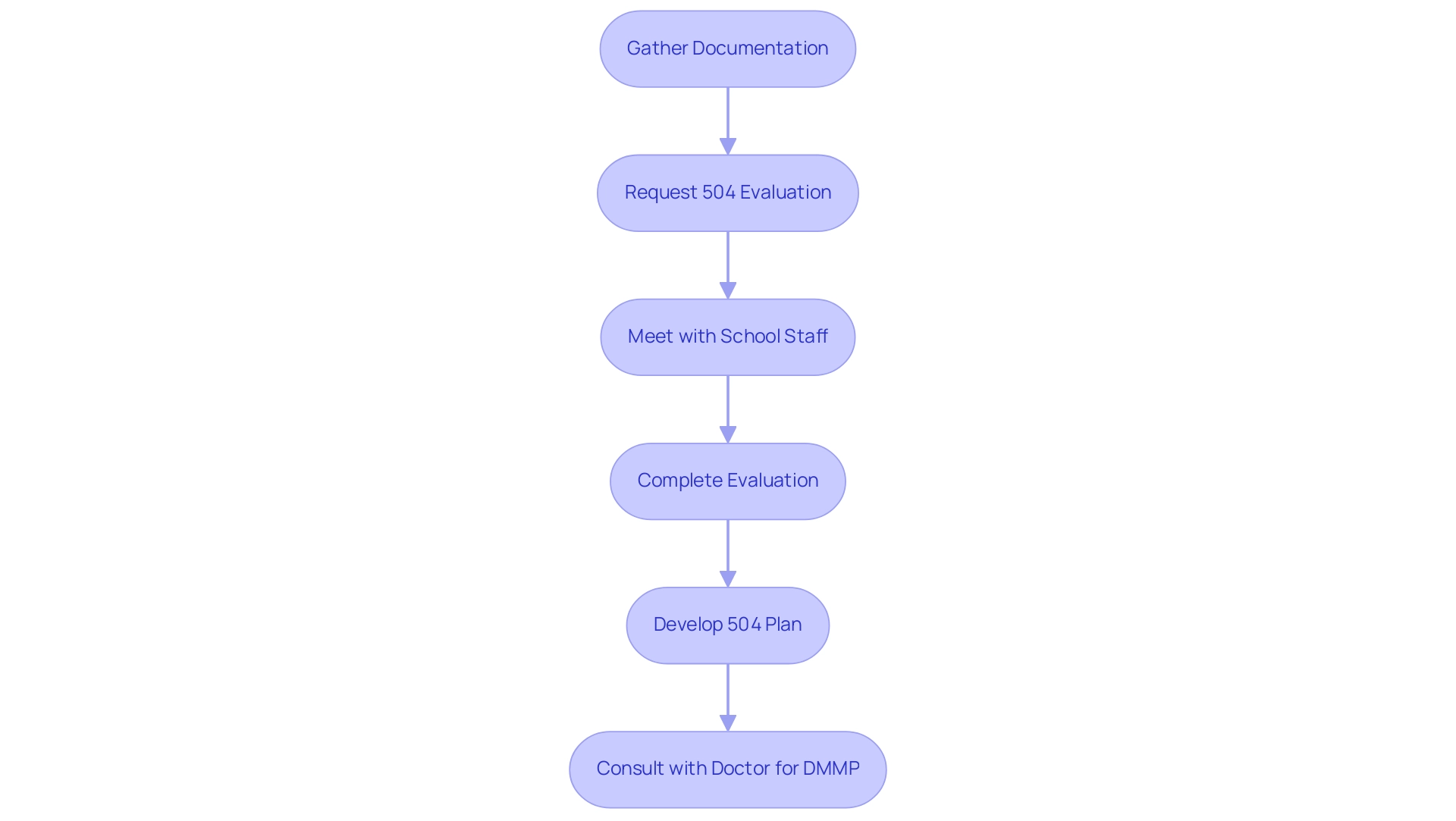
Navigating Challenges: Common Misconceptions About the 504 Plan
Misunderstandings about the American Diabetes Association 504 plan can significantly hinder its effectiveness for individuals managing diabetes. One prevalent myth is that the 504 Plan is exclusively for individuals with severe disabilities. In truth, it is designed to assist any individual whose medical condition substantially limits their major life activities, including learning. This means that individuals with diabetes, regardless of the severity of their condition, are entitled to the same support.
Another widespread misunderstanding is that schools can deny accommodations if an individual is performing well academically. However, it’s understandable to feel that way, yet the essence of the 504 arrangement is to ensure equal access to education, irrespective of an individual's academic performance. This principle is crucial, as it recognizes that an individual may excel in their studies while still facing significant challenges due to their medical condition.
To be eligible for a 504 program, an individual must have a physical or mental condition that substantially limits their primary life activities. This extensive definition emphasizes the importance of the American Diabetes Association 504 plan for a varied group of learners, including those with blood sugar-related conditions.
At T2DSolutions, we are here to support you every step of the way, offering resources and assistance for individuals and families navigating the complexities of the 504 process. Our platform provides guidance on comprehending rights and accommodations, ensuring that individuals with specific health conditions receive the necessary support to thrive in their educational settings.
Expert opinions highlight the importance of dispelling these myths. Educators stress that understanding the 504 framework is essential for all learners, as it promotes an inclusive educational atmosphere. By addressing these misconceptions, parents and educators can create a more supportive environment for individuals with diabetes, ensuring they receive the necessary accommodations outlined in the American Diabetes Association 504 plan to thrive.
Case studies illustrate the enforcement of Section 504, where the Office for Civil Rights investigates complaints regarding violations and provides technical assistance to schools. Non-compliant institutions may face financial repercussions or legal action, reinforcing the importance of adhering to the 504 guidelines. This enforcement mechanism is crucial in upholding the rights of individuals with disabilities, ensuring they receive the accommodations needed to prevent discrimination and promote equitable educational opportunities.
As Saniya Khan, Copy-Editor at EdTechReview, states, "Understanding the 504 framework is essential for all students, as it ensures that their educational needs are met, regardless of their circumstances." Incorporating such insights can further emphasize the importance of awareness and understanding of the 504 framework among educators and parents.

Ongoing Support: Reviewing and Updating the 504 Plan
The 504 strategy is a living document that requires ongoing review and updates to ensure its effectiveness. It's important for parents and educators to come together at least once a year to evaluate the plan's performance and make necessary adjustments that cater to the learner's evolving needs. This process might include:
- Revising accommodations
- Adding new medical information
- Addressing any challenges that have arisen since the last review
Open communication between parents and school staff is vital for ensuring that the 504 Plan continues to support the individual's health and educational success. Regular evaluations not only enhance the plan's relevance but also contribute significantly to the individual's overall academic performance and well-being. As Joshua M. Langberg from Virginia Commonwealth University expressed, "We want to thank the teachers and administrative staff that made this research possible," highlighting the essential role of educators in this collaborative effort.
Moreover, the significance of community and collaboration in managing diabetes is paramount; it is a shared journey that ultimately leads to improved health outcomes. In light of this, it is recommended that schools conduct regular assessments of the American Diabetes Association 504 Plan. Studies indicate that frequent reviews can greatly influence academic success. This aligns with broader discussions on the rights and support for individuals with impairments, as seen in case studies addressing voting rights for individuals with cognitive and emotional impairments, which underscore the necessity of advocacy and support systems in educational settings.
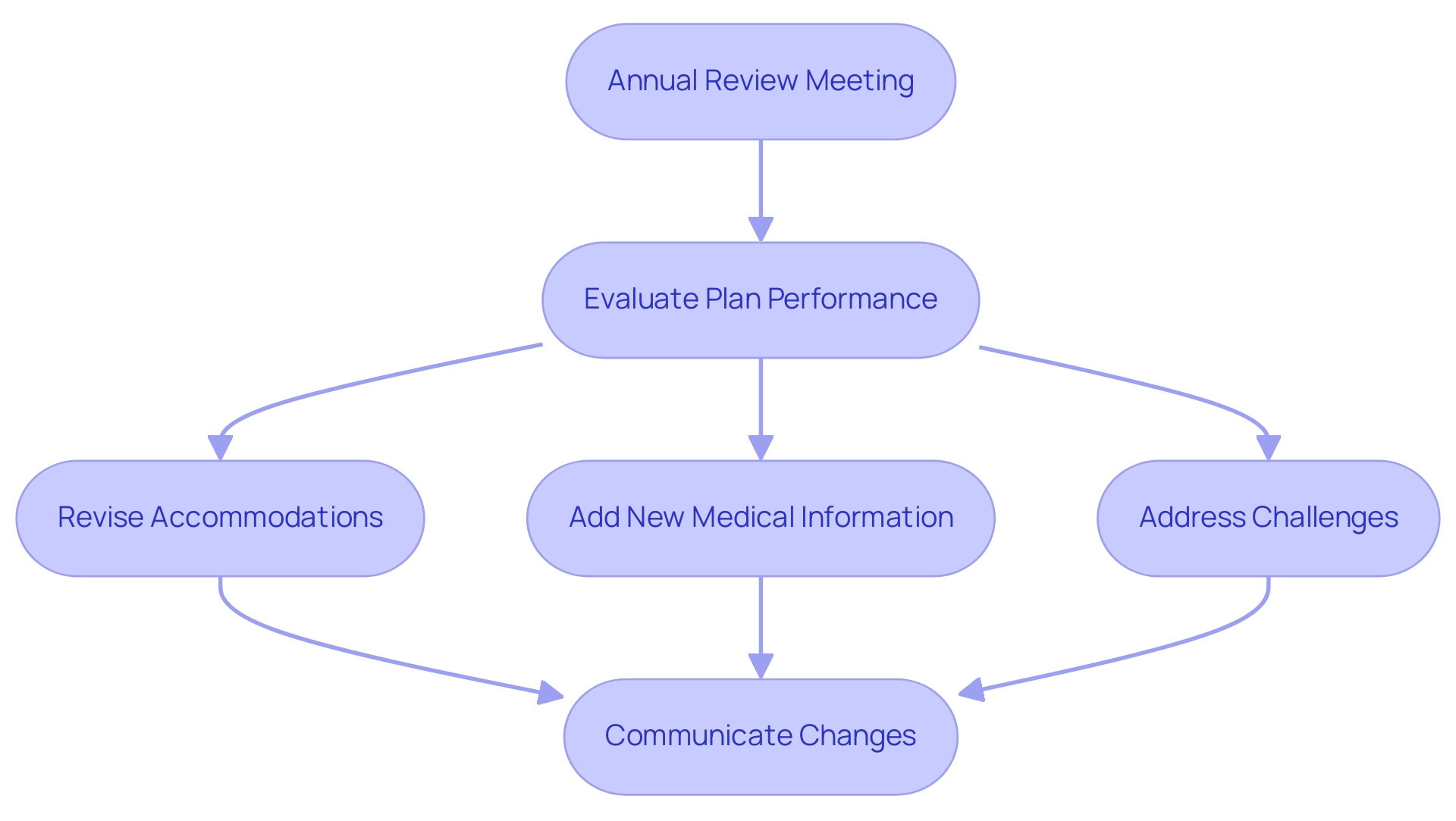
Resources for Advocacy: Tools for Parents and Educators
Parents and educators have access to a wealth of resources designed to bolster their advocacy efforts for the American Diabetes Association 504 Plan. T2DSolutions, a new resource center for education and community support, offers comprehensive guides and templates that outline the process of creating effective 504 Plans. These resources include vital information on the American Diabetes Association 504 plan and essential details regarding legal rights and protections for individuals with health conditions related to blood sugar. It's important to remember that a 504 plan must be reviewed at least yearly to ensure accommodations are up to date.
Moreover, local advocacy groups and online forums serve as invaluable platforms for sharing experiences and strategies among families facing similar challenges. Engaging with these resources not only empowers parents and educators but also fosters a cooperative atmosphere that enhances the educational experience for individuals with health conditions. As Dr. Amy W. Anzilotti states, '[insert quote here].'
By leveraging these tools, advocates can ensure that students receive the necessary accommodations and support according to the American Diabetes Association 504 plan. This ultimately contributes to improved health outcomes and a more inclusive educational setting. This focus on community and collaboration is essential. It is highlighted in the case study on community engagement and support, which underscores the belief that managing diabetes is a collective journey. Remember, you're not alone in this journey; we are here to support you every step of the way.
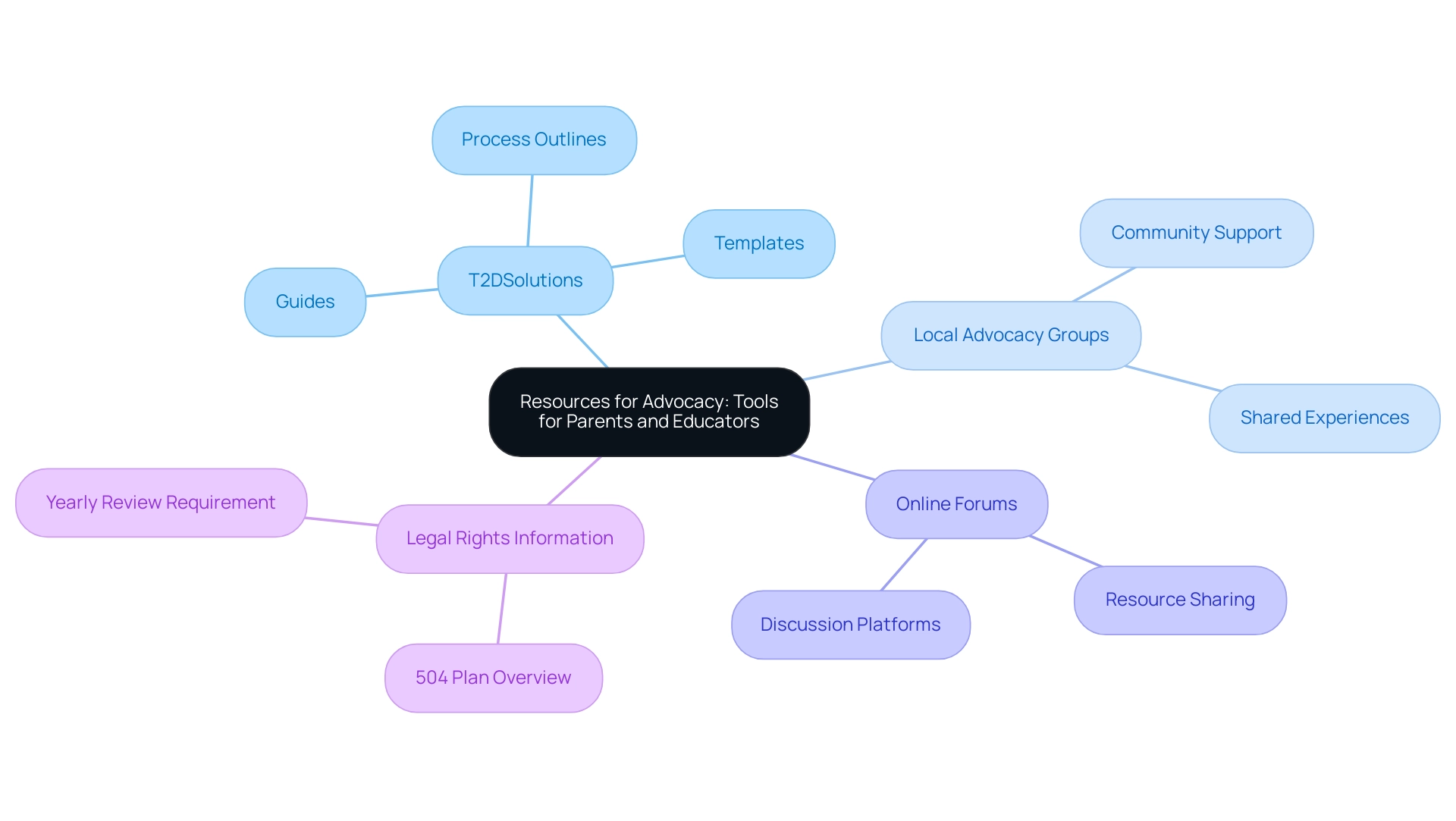
Conclusion
The 504 Plan plays a vital role in supporting students with diabetes, offering essential accommodations that promote both their academic success and health management. By creating a structured framework, the 504 Plan allows these students to engage fully in school activities while effectively managing their condition.
Collaboration among parents, educators, and healthcare providers is key to developing and implementing an effective 504 Plan. Through continuous communication, we can foster a supportive environment that enhances academic outcomes and overall well-being. Understanding the legal protections under the 504 Plan empowers families to advocate for their children's rights, ensuring they receive the appropriate support they deserve.
It's important to address misconceptions about the 504 Plan to promote inclusivity in education. All students with disabilities, including those with diabetes, are entitled to accommodations tailored to their unique needs, regardless of their academic performance.
Regularly reviewing and updating the 504 Plan is crucial to adapt to students' evolving requirements and ensure its ongoing effectiveness. By advocating for these essential accommodations, we can create a more inclusive educational environment, ultimately improving the educational experiences and health outcomes for students with diabetes. This collective effort not only supports their academic success but also nurtures their overall social and emotional well-being. Remember, you're not alone in this journey; together, we can make a difference.
Frequently Asked Questions
What is the 504 strategy?
The 504 strategy is a framework that outlines specific adjustments needed for individuals with disabilities, including those managing blood sugar issues, to ensure equitable access to education.
Why is the 504 plan important for individuals with diabetes?
The 504 plan is crucial for enabling individuals to manage their health needs effectively while fully participating in school activities, especially given the rising prevalence of Type 1 diabetes among school-aged children.
What are some accommodations provided under the 504 plan for students with diabetes?
Accommodations may include regular blood sugar monitoring, access to snacks and water, and the ability to take breaks as necessary.
How does physical activity relate to students with Type 1 diabetes?
Physical activity plays a vital role in managing blood sugar levels, and students with Type 1 diabetes may require additional support during exercise.
What role do parents and educators play in the 504 plan?
Parents and educators are pivotal in advocating for the implementation of the 504 plan to meet the needs of individuals with health conditions related to blood sugar.
What legal framework supports the 504 plan?
The 504 plan is rooted in Section 504 of the Rehabilitation Act of 1973, which protects individuals with disabilities from discrimination in federally funded programs.
What types of adjustments are schools required to provide under the 504 plan?
Schools must provide adjustments such as access to medical care during school hours, allowing individuals to carry their supplies, and modifying testing conditions as needed.
What recent legal developments could affect the 504 plan?
The Texas v. Becerra case involves a lawsuit that could undermine Section 504, making it more difficult for students to qualify for necessary accommodations.
How does the 504 plan foster inclusivity in schools?
The 504 plan facilitates essential medical accommodations and promotes inclusivity by ensuring individuals with blood sugar issues receive the assistance they require to engage fully in school life.
Are individuals with diabetes in postsecondary education protected under the 504 plan?
Yes, individuals with diabetes in postsecondary education are also protected under federal regulations and can seek reasonable accommodations from their educational institutions.
